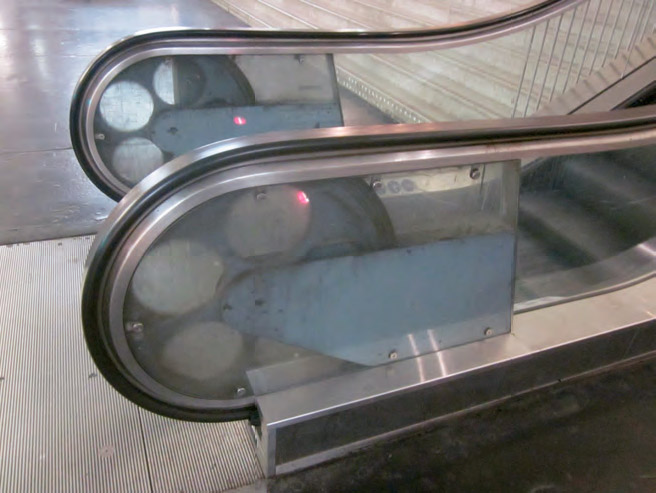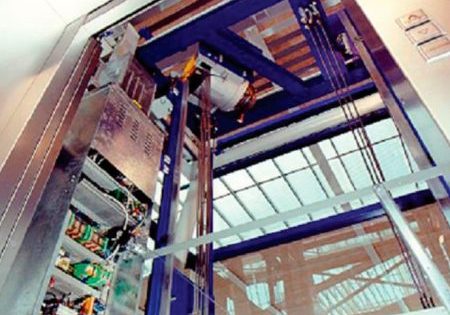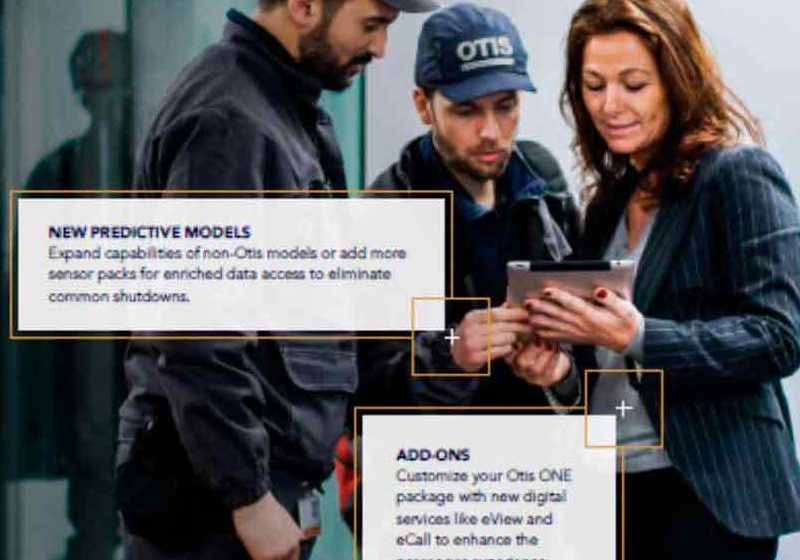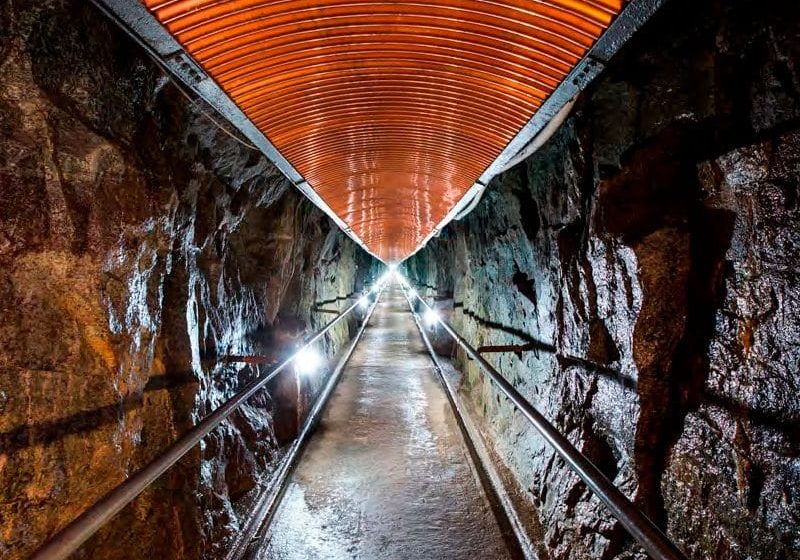U.K. Evolution
Dec 1, 2020

In this Readers’ Platform, your author discusses codes and events that have influenced escalator design.
This issue’s focus topic presents an opportunity to consider the evolution of the U.K. escalator sector, with reference to some key developments and a comparison between jurisdictions. Table 1 compares some requirements of U.K. BS 2655-4:1969 with those of the European EN 115-1:2017 and ASME A17.1-2016. While some of the differences reflect changes arising from metrification and cultural/historical factors drawing upon local building codes, others are worthy of wider consideration.
BS 2655-4:1969 was the first British Standard (BS) specific to escalators and included several engineering provisions that exceed those of today’s European (EU) standard. Specifically:
- A 4-mm maximum clearance between adjacent steps, as opposed to the current 6 mm, which is perhaps a reflection of the emergence of cleated step risers and meshing steps
- A step-to-skirt clearance, the sum of which should not exceed 6.5 mm (maximum 5 mm on one side), as opposed to the current 7 mm (maximum 4 mm on one side) Regarding determination of structural loadings, a different approach is taken but does not differ significantly. Compare BS 2655’s step contract load of 290 kg/m2 against today’s 60 kg, 90 kg and 120 kg per step; an overall structural load based upon 440 kg/m2 on the exposed step tread against today’s 510 kg/m2; and step static load of 580 kg/m2 against today’s 610 kg/m2. Factors of safety, though, are reduced, from the BS 2655 safety factor of 8 for the drive chain and step chain to 5 under EN 115. This is, perhaps, reflective of experience and improved manufacturing and quality-assurance provisions.
Under BS 2655, safety factors applied are 3 to tracks, based on a step loading of 440 kg/m2; step frames, based on a loading of 580 kg/m2; and to the truss itself, based on a step loading of 440 kg/m2. The current EN 115 standard opts for a prescribed loading.
A realistic risk-based approach should have retained the prescriptive requirement for an auxiliary brake. And, while A17.1 does not prescribe an auxiliary brake, its provisions relating to alternative drive-chain safety exceed those of EN115-1 and are perhaps a better measure and mitigation of risk.
BS 2655 required an additional brake on all escalators incorporating a chain or belt link between the drive machine and step band. The introduction of the opt-out to this requirement, based on the use of multiplex or multiple chains, which was introduced in EN 115:1983, was, in my view (and in light of recent failures) a retrograde step. The change from a prescribed mitigating safety measure to one based on factors of safety may have, in light of improvements in technology and quality control, appeared attractive. The approach, though, is heavily reliant on the quality of materials and manufacture, and satisfactory planned maintenance. A realistic risk-based approach should have retained the prescriptive requirement for an auxiliary brake. And, while A17.1 does not prescribe an auxiliary brake, its provisions relating to alternative drive-chain safety exceed those of EN 115-1 and are perhaps a better measure and mitigation of risk.
The question of unintended reversals or runaways is perhaps the most pressing issue currently facing the industry and something I have previously written about in more detail. There is no plausible rationale that supports the EN 115 application of auxiliary braking only to installations exceeding 6 m in vertical rise, which is, in fact, a diminution from the old BS 2655 provision and an area in which the A.17 code surpasses EN 115-1.
In the 1970s, die-cast aluminum unisteps began to replace the traditional fabricated step. The result was greater accuracy of step construction; reduced overall load upon the truss; and an easier life for those of us undertaking step removal/replacement, in terms of the loads we were required to manually handle.
The events surrounding the development of the U.K. and EU application of skirt deflectors are of interest, as this was implemented in the U.K. by way of guidance, rather than law.
In 1979, a side-of-step entrapment injury to a child on a Birmingham, U.K., department store escalator provided the initial impetus for the application of skirt deflectors, which was set out in U.K. HSE PM34, November 1983, and repeated in the U.K. version of EN 115:1983. Their use became mandatory for new escalators in the U.K. ordered after January 1, 1984, and, though initially resisted, was eventually incorporated into EU EN 115:1995 by Amendment 2, 2004, as a requirement for new escalators in Europe. PM34 also required that skirt deflectors be fitted to existing escalators wherever reasonably practicable.
The events surrounding the development of the U.K. and EU application of skirt deflectors are of interest, as this was implemented in the U.K. by way of guidance, rather than law. Enforcement was achieved by way of Health and Safety Executive (HSE) liaison with the U.K. industry and the PM34 onus upon purchasers of escalators to ensure compliance. Provision for enforcement already existed in sections 3 and 4 (protection of persons other than employees and duties of persons concerned with premises to persons other than employees) of the U.K. Health & Safety at Work Act (HSWA). While enforcement relating to existing escalators was somewhat less rigorous, the reasonable practicability measure of risk, coupled with the requirements section 4 of the HSWA and with consistent industry advice, encouraged the great majority of escalator operators to retrofit their installations.
A number of alternative solutions existed, mainly in the rail transportation sector, but the deflector brush emerged as the established solution, mainly because of its relatively straightforward application as a retrofit to existing escalators.
An important, if less obvious, improvement is the provision of maintenance controls. When I started in the industry, these were rare, with only the start key switches used to control movement during maintenance and repair work. A tragic fatal accident during a step chain replacement in 1980 provided the impetus for the retrofit of maintenance controls. This was successful to the extent that it is now rare to find an escalator not equipped with what today’s standards consider a basic safety provision.
The question of the most appropriate angle of inclination presents an interesting exercise in risk assessment. A maximum 30° incline applies in the U.S., while Europe permits a 35° incline for escalators with vertical rise less than 6 m. A straightforward intuitive approach indicates that a reduced angle of incline results in a lower risk of fall. So, in applying a 35° incline, we accept an increased risk of passenger fall in exchange for an economic benefit in the form of a reduction in escalator footprint. The theory underlying this tradeoff, if, indeed, there is one, presents an interesting question in risk management.
Glass balustrades were developed in the 1950s and became predominant during the late 1960s and through the 1970s. The mullions included in the early designs began disappearing in a quest for a wholly transparent balustrade and sightline, such that, by the 1980s, the design was standard in the retail sector.
However, in the early 1980s, the so-called “slimline” escalator made its debut. While the change from opaque to glass balustrades had complicated the design of handrail systems, the problems were exacerbated because of the further reductions in space necessitated in the slimline design. Though early issues relating to the stiffness of these balustrades have been more or less resolved, the reduced cross-section of the slimline handrail, and problems relating to these handrail drives, still arise. Couple these aesthetically driven design changes with cost-reduced (or value-engineered) tracking and component mounting/bracket systems, and the result is a limited equipment life with lower levels of resilience and reliability. We have moved forward in terms of safety devices but have taken some backward steps in terms of product engineering.
In 1987, a tragic fire at the London Kings Cross underground station turned the U.K. industry’s focus to the maintenance and cleaning of escalators, and associated fire risks. I recall attending an incident in which a supermarket escalator had caught fire in the early hours of the morning. The fire brigade extinguished the fire, which was caused by a drive motor burnout. The firefighters used crowbars to remove the upper tank-trap, prompting both the insurers and I to question whether it really had been necessary to use a hydraulic breaker to separate the step chain and an ax to chop out 20 steps and the side skirts, and to cut the handrails. The fire officer explained (while attempting to suppress a grin) that he couldn’t be certain that the fire had not spread into the truss, so he thought it best to take no chances. Perhaps having been called out at 2 a.m. on a cold and dark morning presented a good opportunity for the guys to test out their training. Our investigation revealed that a wheel on a motor-driven floor-scrubber being transported on the escalator became wedged between a step and the underside of the skirt decking, fracturing the step. The escalator continued for a time, but the step eventually became dislodged and collided with the upper combs, locking the step band and causing the motor to burn out. (There were no comb switches on the escalator.)
I recall that, around the same time, issues were being raised relating to the flammability and performance of materials under fire conditions. Contracts were let for balustrade panel replacement and for replacement of steps that incorporated a plastic step tread, which, when ignited, produced toxic fumes. These steps were replaced with modern unisteps.
In 1987, a tragic fire at the London Kings Cross underground station turned the U.K. industry’s focus to the maintenance and cleaning of escalators, and associated fire risks.
My more recent fire-related investigations have involved lighting ballasts that ignited after having been allowed to exceed their shelf life and deteriorate to an unacceptable condition. In one case, a contractor manager advised that, at the time of the fire, the circuit had been isolated. If this were to have been believed (and it wasn’t), the incident could only have been attributed to spontaneous combustion, rather than to a handrail lighting system’s deteriorated electrical wiring and ballast units, which was, in fact, the case.
In regulatory terms, we are, in general, well served by the EU Product Directives and the standards, in terms of new equipment. We are less well served, I think, in specific domestic regulation, which is limited to Section 19 of the U.K. Workplace (Health, Safety & Welfare) Regulations 1992. While the requirements of Section 19 are wide and far-reaching, these provide little by way of specific guidance, and in that sense, we rely upon references to the standards and the U.K. SAFed Escalator Guidance, which can prove problematic when considered in court.
In terms of technological development, we have seen no successful radical innovation in escalator design, although we have witnessed a few crash-and-burn product releases. We continue to employ chain technologies, coupled with the basic geometric form of the step design, metal track systems and rubber/polymer handrails.
Technological development has been incremental, with the development of existing system elements, rather than radical innovative leaps. The development of handrail drives has been a particular focus for attempts at innovation and improvement, and some of these have worked well, though others have not. Microprocessors have replaced the traditional relay panels
(though, outside of monitoring, I doubt the need for these on an escalator) and energy-saving drives, both of which are technologies drawn from other sectors. My experience with so-called “green” or “lubrication-free” chains has been negative, with these products failing to live up to expectations in terms of performance and longevity.
Overall, the diminution of engineering standards that arose due to reduced factors of safety introduced in EN 115:1983, compared to BS 2655-4, has contributed to the emergence of a less-robust, less-safe product. I am strongly of the view that we shall soon revert to the universal application of auxiliary brakes. I doubt that the drafters of EN 115:1983 foresaw the unintended consequence of their work in the “value-engineered” designs now prevalent and enabled by way of a proliferation of computerized engineering, design and manufacturing systems.
More recently, the key factor driving competition has been price coupled with aesthetics, although the aesthetics factor appears, for the moment, at least, pretty well exhausted. The effects of globalization have been such that the competitive forces driving unit price have shifted production from Europe to China (and China has the largest domestic demand, which is a significant proportion of global demand, and, therefore, an inherent competitive advantage). I do, however, detect a welcome shift in emphasis from price to quality. The nature of escalators is such that unplanned downtime is often so disruptive to business operations and so significant in terms of commercial loss, that the additional capital cost of a superior product is preferable to the risk of disruption and loss resulting from price-driven considerations.
Turning to current matters, I note an increased promotion of step riser advertising, of which I remain skeptical. Questions arise in relation to the coefficient of friction of the material adhered to the step riser, in relation to the consequence of the detachment of this and possible failure or step pile-up. Some years ago the U.K. HSE, among others, undertook research into the visual perceptions experienced by escalator users in relation to the risk of falling due to disorientation. As far as I am aware, no similar research has been conducted into the effects of step advertising in relation to risks of passenger falls.
I note also the widespread marketing of handrail sanitization equipment, more often based upon UV effects, in relation to COVID-19. I also note commentaries in social media questioning the efficacy of these products. Once again, supporting research appears sparse. While I am no scientist, I would have expected to see scientific evidence in support of the functionality and effectiveness of these devices in terms of destroying the coronavirus. There are also concerns relating to the mechanical application of these devices and the possibility of the introduction of other hazards. I have no inherent objections to these products or to those promoting them; I do, however, take the view that more research is required in terms of the safety of step advertising. The current vogue in handrail sanitization is of interest, if only in terms of how quickly firms have been able to design and produce UV devices, many of which come with extravagant claims as to their effectiveness. The need may be pressing and the window of opportunity short (or, we hope it will be), but I harbor an underlying suspicion that a simple regime of manual periodic cleaning, applying a suitable disinfecting agent, may prove at least equally, if not more, effective.
In conclusion, I see many more safety devices, all of which are welcome, with a wholly unwelcome deterioration in mechanical design, driven by aesthetics in terms of spatial reduction and what is often ill-considered cost reduction. I envisage that there is further scope for the application of new technologies in terms of sensor-based safety devices and in a review of the EN 115-1 design provisions, including a wider application of auxiliary brakes.
Get more of Elevator World. Sign up for our free e-newsletter.








